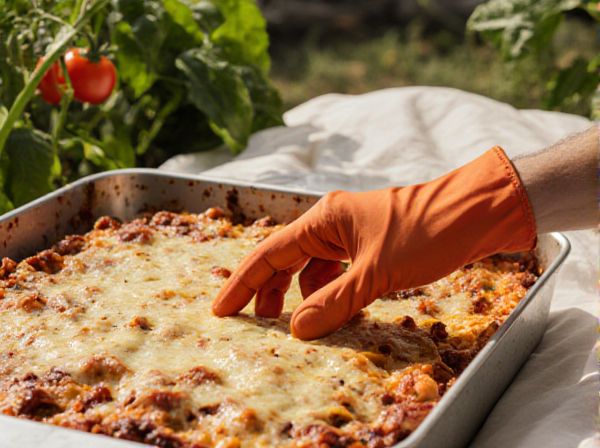
Lasagna bed vs Raised bed Illustration
Lasagna beds use layers of organic materials like kitchen scraps, compost, and mulch to create nutrient-rich soil directly on the ground, ideal for improving poor soil conditions. Raised beds, constructed with frames filled with quality soil, offer better control over soil composition, drainage, and accessibility. While lasagna beds emphasize soil-building through decomposition, raised beds provide immediate structure and versatility for various gardening needs.
Table of Comparison
| Feature | Lasagna Bed | Raised Bed |
|---|---|---|
| Construction | Layered organic materials (compost, leaves, kitchen scraps) | Framed soil above ground, often wood or metal |
| Soil Quality | Rich, nutrient-dense, self-composting soil | Depends on added soil mix, may require amendments |
| Drainage | Excellent due to organic layers | Good, relies on soil and bed design |
| Maintenance | Low, natural decomposition replenishes nutrients | Requires regular soil amendments and weeding |
| Sustainability | High; recycles organic waste and enriches soil | Moderate; depends on materials used |
| Cost | Low; uses readily available waste materials | Varies; includes cost of framing and soil |
| Setup Time | Longer; requires layering and composting time | Quick; soil can be added immediately |
Introduction to Lasagna Beds and Raised Beds
Lasagna beds are a type of raised bed garden that uses layers of organic materials like compost, straw, and kitchen waste to create nutrient-rich soil through decomposition. Raised beds are elevated garden plots that provide improved drainage, soil aeration, and ease of access for planting and maintenance. While traditional raised beds rely on pre-mixed soil, lasagna beds build fertility naturally over time by layering biodegradable materials directly in the bed.
Key Differences Between Lasagna Beds and Raised Beds
Lasagna beds utilize a layered composting technique combining organic materials such as kitchen scraps, leaves, and grass clippings to build nutrient-rich soil, while raised beds consist of a constructed frame filled with pre-mixed soil or garden soil. Lasagna beds emphasize natural decomposition and soil fertility over time, requiring less initial soil preparation compared to raised beds, which provide immediate planting readiness and better control over soil quality. Raised beds offer improved drainage and easier pest management through physical barriers, whereas lasagna beds promote sustainable garden practices by recycling organic waste directly in the planting area.
Benefits of Using Lasagna Beds
Lasagna beds offer enhanced soil fertility through layered organic matter that decomposes in place, promoting nutrient retention and improved moisture levels compared to traditional raised beds. This method reduces the need for tilling and fertilizers by naturally enriching the soil, supporting robust plant growth and microbial activity. Gardens using lasagna beds benefit from sustainable waste recycling and long-term soil structure improvement, leading to healthier crops and reduced maintenance.
Advantages of Traditional Raised Beds
Traditional raised beds provide superior soil control and improved drainage compared to lasagna beds, reducing waterlogging and root rot risks. They enable easier access for planting and maintenance due to defined borders and consistent depth. These beds also offer greater flexibility in soil composition, allowing gardeners to customize nutrient levels for optimal plant growth.
Soil Composition: Lasagna Beds vs Raised Beds
Lasagna beds feature layered organic materials like kitchen scraps, leaves, and compost, creating nutrient-rich, loamy soil through natural decomposition. Raised beds typically use a pre-mixed soil blend combining topsoil, compost, and organic matter for immediate, well-draining cultivation. The key difference lies in soil development: lasagna beds build soil fertility over time, while raised beds offer a controlled, uniform growing medium from the start.
Setup Process and Materials Needed
Lasagna beds use layering of organic materials like compost, cardboard, and mulch to create nutrient-rich soil directly on the ground, requiring minimal initial soil preparation. Raised beds need a constructed frame from materials such as wood, stone, or metal, filled with pre-mixed topsoil and compost, demanding more upfront building effort. The lasagna bed setup is ideal for improving poor soil conditions quickly, while raised beds offer better control over soil quality and drainage.
Maintenance and Longevity Comparison
Lasagna beds require regular layering of organic materials to maintain soil fertility and structure, demanding more frequent attention but promoting sustainable nutrient cycling. Raised beds, constructed with durable materials like wood or metal, offer longer structural longevity with less intensive upkeep, primarily focusing on soil replenishment and pest control. While lasagna beds excel in organic growth cycles, raised beds provide a stable, low-maintenance framework suitable for long-term gardening.
Suitability for Different Garden Types
Lasagna beds excel in small urban gardens and areas with poor soil, as their layered organic materials improve soil fertility and structure over time. Raised beds offer versatility for various garden types, including larger landscapes, by providing controlled soil conditions and improved drainage. Both methods suit different gardening needs, with lasagna beds ideal for sustainable, low-maintenance cultivation and raised beds better for precise crop management.
Cost Analysis: Lasagna Bed vs Raised Bed
Lasagna beds typically incur lower initial costs due to the use of layered organic materials like compost, leaves, and kitchen scraps, minimizing the need for purchasing soil and amendments. Raised beds require investment in materials such as lumber, screws, and quality soil, resulting in higher upfront expenses but often greater durability and control over soil composition. Long-term maintenance costs for lasagna beds are minimal, benefiting from natural decomposition, whereas raised beds may require periodic soil replenishment and structural repairs, impacting overall cost-effectiveness.
Which Bed Type Is Best for Your Garden?
Lasagna beds use layered organic materials to create nutrient-rich soil, promoting faster decomposition and improved moisture retention, ideal for gardeners seeking low maintenance and quick soil improvement. Raised beds offer better drainage, soil control, and ease of access, making them suitable for growing a wide range of plants in limited or poor soil conditions. Choosing between lasagna and raised beds depends on your garden's soil quality, maintenance preference, and the types of crops you plan to cultivate.
Lasagna bed vs Raised bed Infographic

 gardendif.com
gardendif.com